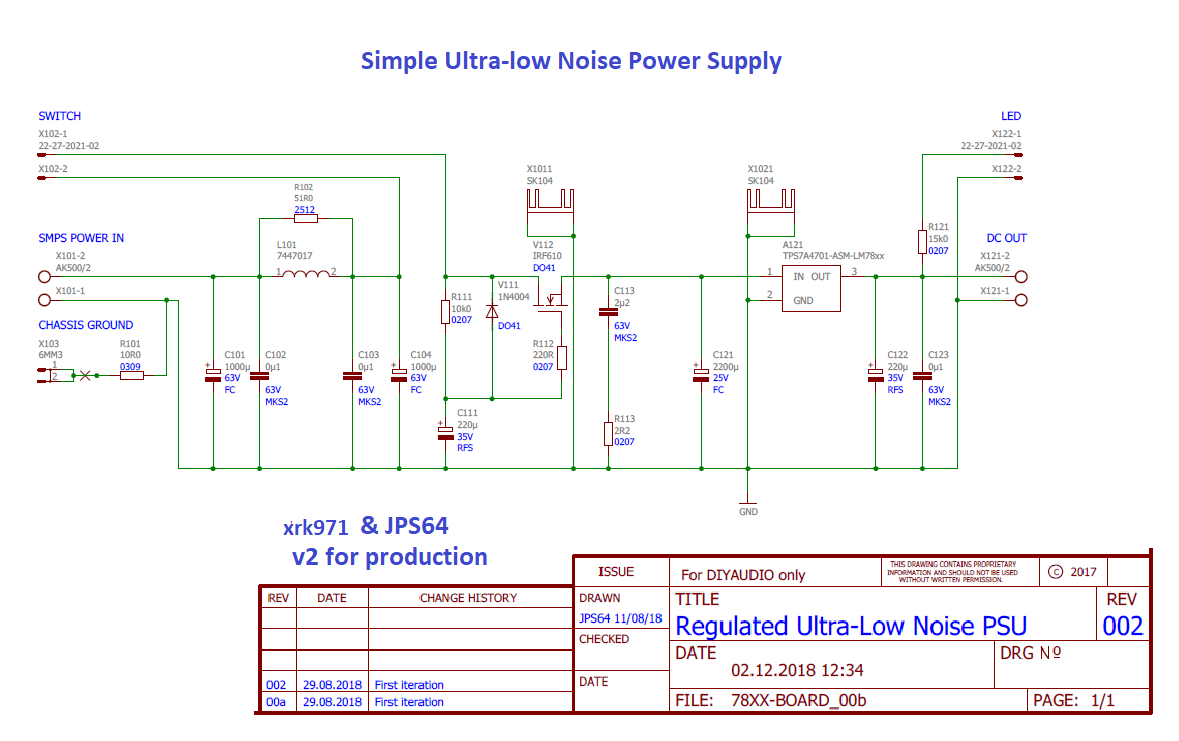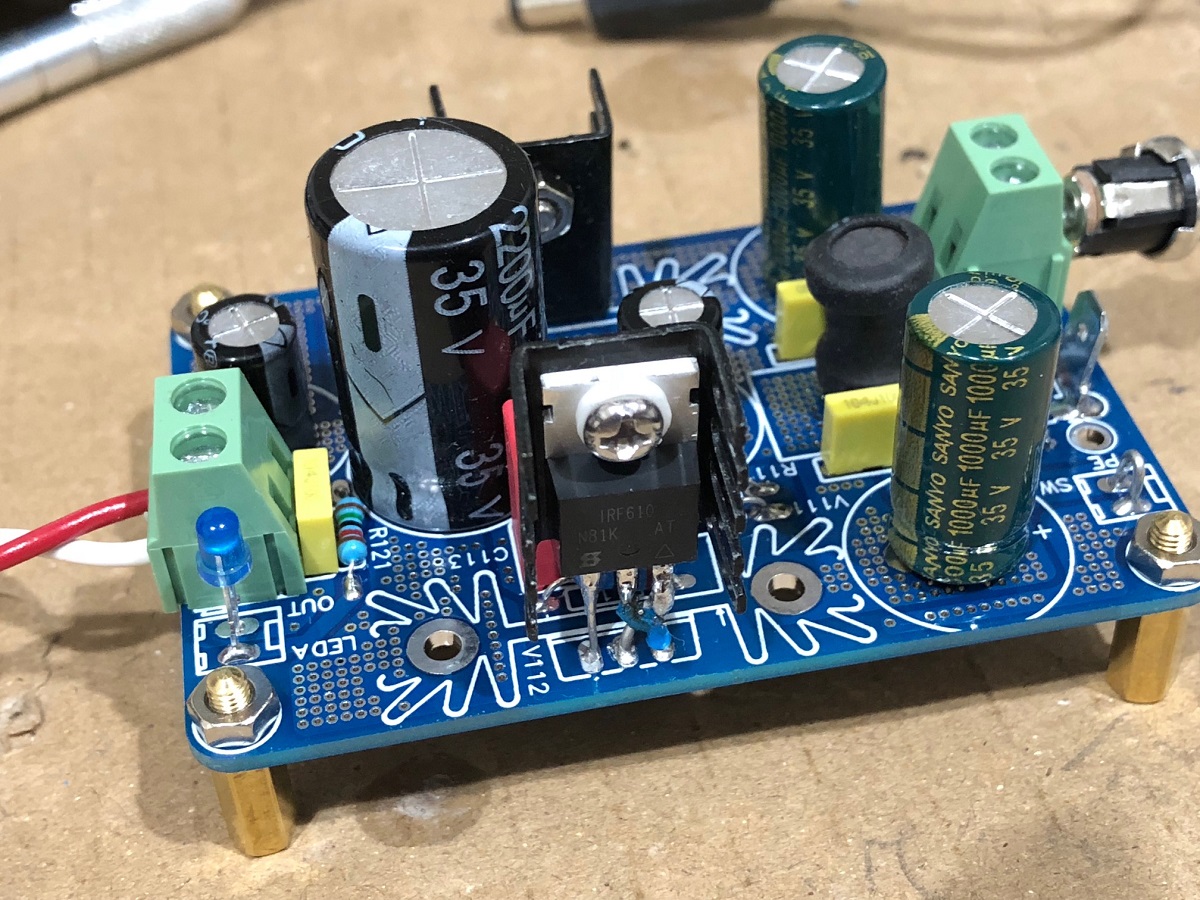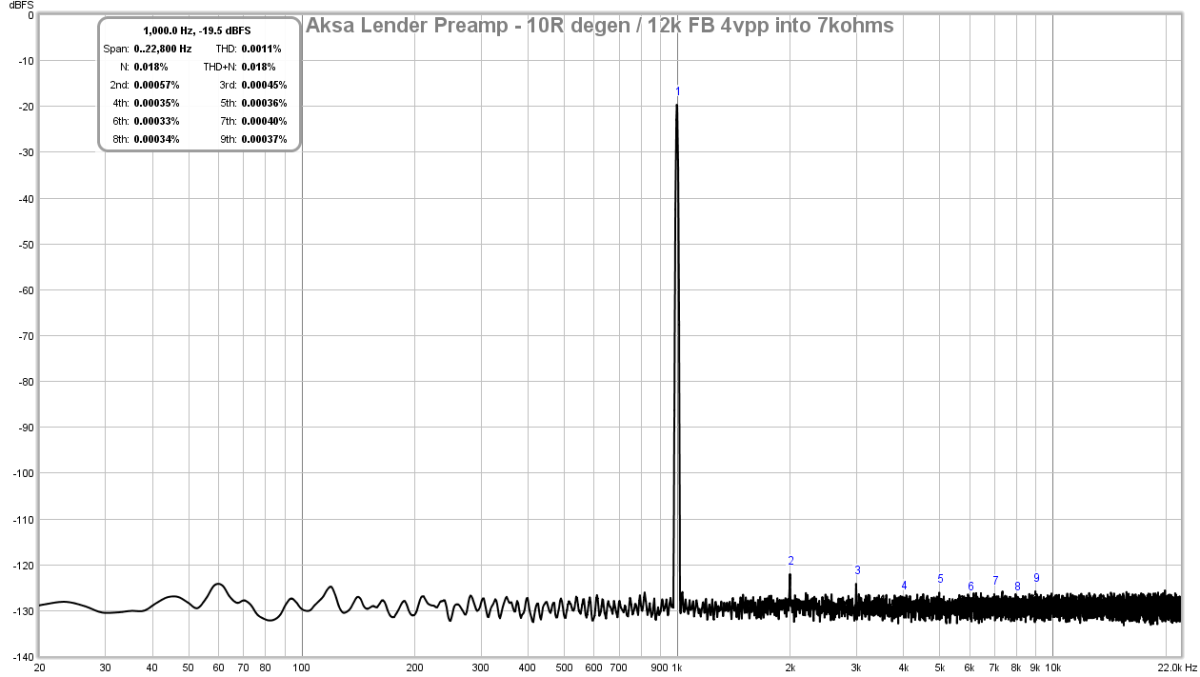Those are not exactly used in the consumer electronics branche and audio. Maybe it is personal but I am fed up with dying switchers that are true EMI transmitters in their limited lifetime.
I like to design "green" but saving energy (mainly price really) for 2 years and then ending up in landfill is not green IMHO. A real power switch also seems to be too expensive so most are always on mains which defies their advantage if I may say so. There are nice power efficient low noise LDO regs that want to marry r-core transformers. Real good ones from Kitamura Kiden preferably.
We are talking 15 VA max. here I guess. The world won't get any better if these PSU's are 90% power efficient but always powered on creating electrosmog continuously and then being discarded after a few years. Till now the ones that are defending these low power SMPS are mainly people that design them or have them designed and produced in China
I like to design "green" but saving energy (mainly price really) for 2 years and then ending up in landfill is not green IMHO. A real power switch also seems to be too expensive so most are always on mains which defies their advantage if I may say so. There are nice power efficient low noise LDO regs that want to marry r-core transformers. Real good ones from Kitamura Kiden preferably.
We are talking 15 VA max. here I guess. The world won't get any better if these PSU's are 90% power efficient but always powered on creating electrosmog continuously and then being discarded after a few years. Till now the ones that are defending these low power SMPS are mainly people that design them or have them designed and produced in China
Last edited:
SMPS - DAC1541 from Soekris
Not one, but three of them
http://www.soekris.dk/images/dac1541_open_1200.jpg
Not one, but three of them
http://www.soekris.dk/images/dac1541_open_1200.jpg
SMPS - DAC1541 from Soekris
Not one, but three of them
http://www.soekris.dk/images/dac1541_open_1200.jpg
Not good. Those are off the shelves smps , with all the EMI/Common Mode noise / Diff noise associated. Furthermore the architecture of those SMPSs is important (Zero valley Sw/full bridge is best , quasi resonant is ok but most are none of the above.)
Why the need for SMPS then?
Benchmark is using SMPS for DAC-3 and for the AHB2 power amp. Both measure as SOA and sound very good (both Stereophile A+ recommended). They say they can get better performance using switchers. Takes very careful engineering to get it right, though. Not something that can be done well at a very low price point, it would seem.
Keywords: lighter (cheaper transport), cheaper, smaller footprint, no need for large heatsinks, often OEM so less own design and certification costs, energy saving/efficiency demands (EU). After the decision is made then one tries to make the best out of it and defends the choice. Well designed SMPS certainly exist but at a price which is unfortunately is key in consumer electronics. In general they perform less good than linear PSU's, at least for low power applications like the 5V topic suggests. When batteries are needed as power source then I certainly steer away. Batteries are definitely not green compared to mains voltage.
Copper is expensive
True but compared to the noise generators they are feeding that is almost negligable
Copper is expensive
LDOs are only good to uV of noise , to go beyond you need active filters. Furthermore I seen testing of impedance of LDOs at close to DC (those low noise ones)..not great.
True but compared to the noise generators they are feeding that is almost negligable
Last edited:
Those are not exactly used in the consumer electronics branche and audio. Maybe it is personal but I am fed up with dying switchers that are true EMI transmitters in their limited lifetime.
I like to design "green" but saving energy (mainly price really) for 2 years and then ending up in landfill is not green IMHO. A real power switch also seems to be too expensive so most are always on mains which defies their advantage if I may say so. There are nice power efficient low noise LDO regs that want to marry r-core transformers. Real good ones from Kitamura Kiden preferably.
We are talking 15 VA max. here I guess. The world won't get any better if these PSU's are 90% power efficient but always powered on creating electrosmog continuously and then being discarded after a few years. Till now the ones that are defending these low power SMPS are mainly people that design them or have them designed and produced in China
Thumbs up!
//
Those are not exactly used in the consumer electronics branche and audio. Maybe it is personal but I am fed up with dying switchers that are true EMI transmitters in their limited lifetime.
I like to design "green" but saving energy (mainly price really) for 2 years and then ending up in landfill is not green IMHO. A real power switch also seems to be too expensive so most are always on mains which defies their advantage if I may say so. There are nice power efficient low noise LDO regs that want to marry r-core transformers. Real good ones from Kitamura Kiden preferably.
We are talking 15 VA max. here I guess. The world won't get any better if these PSU's are 90% power efficient but always powered on creating electrosmog continuously and then being discarded after a few years. Till now the ones that are defending these low power SMPS are mainly people that design them or have them designed and produced in China
A real power switch is a big disadvantage from a practical standpoint for me. Standby power consumption is minimal in a good design. I have seen app notes for QR flyback converters that claim 100mW in this state.
Linear PSU from allo , first tests 2A. Audioband noise at 200nV
I presume that the linear PSU will be arriving soon, can you share features & specifications in advance?
Jee. I missed the thread anniversary. 
The thread is alive since more then a year by now and I'm still enjoying my well buffered iPowers.
cdsgames announced a while ago - somewhere else - that they're close to finish their linear supply. Unfortunately pricewise - according to cdsgames - it seems we'll not gonna end up in the iPower ball park of $50 with that one. It actually won't come even close.
It actually won't come even close.
I still havn't given up on Allo to get a HQ SMPS out at well below $100 that'll beat the iPower. (And that should include a nice low ESR buffer.)
The thread is alive since more then a year by now and I'm still enjoying my well buffered iPowers.
cdsgames announced a while ago - somewhere else - that they're close to finish their linear supply. Unfortunately pricewise - according to cdsgames - it seems we'll not gonna end up in the iPower ball park of $50 with that one.
I still havn't given up on Allo to get a HQ SMPS out at well below $100 that'll beat the iPower. (And that should include a nice low ESR buffer.)
I actually like the Soekris approach. I doubt that his DAC sounds noisy. 
It is pretty much in line with my thinking that the first power stage doesn't need to be in the uV noise ballpark - at least from a technical point of view.
I also used similar Meanwells (turned to 5.5V out) and a rather high quality LDO from inmate Mravlca. In think I ended up below $50. And that Meanwell/Mravlca solution also worked quite well.
And the other nice thing - as Soekris shows - is, you can easily scale the solution up.
Each power rail will become completely separated.
It is pretty much in line with my thinking that the first power stage doesn't need to be in the uV noise ballpark - at least from a technical point of view.
I also used similar Meanwells (turned to 5.5V out) and a rather high quality LDO from inmate Mravlca. In think I ended up below $50. And that Meanwell/Mravlca solution also worked quite well.
And the other nice thing - as Soekris shows - is, you can easily scale the solution up.
Each power rail will become completely separated.
I actually like the Soekris approach. I doubt that his DAC sounds noisy.
It is pretty much in line with my thinking that the first power stage doesn't need to be in the uV noise ballpark - at least from a technical point of view.
I also used similar Meanwells (turned to 5.5V out) and a rather high quality LDO from inmate Mravlca. In think I ended up below $50. And that Meanwell/Mravlca solution also worked quite well.
And the other nice thing - as Soekris shows - is, you can easily scale the solution up.
Each power rail will become completely separated.
I'm afraid that Mravlca/Ales has not been active on the forum or FleaBay for quite a while... a good alternative could be this alexey.ivanov | eBay (sorry for the plain link, Firefox is playing silly buggers and I can't be bothered to reset, clean cache or use another browser right now...)
Thx for the link. I'll bookmark it.
However.
I do think, and that's also been confirmed by inmate iancanada on one of his projects,
that the potentially best solution is a big supercap buffer (acting as a kind of battery),
similar to what the car industry is using since years.
Basically you'd just need a supercap-buffer "charger" as power supply.
And that charger wouldn't need to come @ highest audiophile qualities (and prices).
With my current approach iPower + 47kuF buffer + filter - I'm half way.
And that setup is definitely better than my Meanwell+mravlca or iPower standalone
options (or my linear options).
I hoped (and understood back then) that Allo had been turning into that direction.
Now they seem to be back to that old-school thinking of "linear" supplies!?!?
Allo probably could have even used their 11$ SMPS as charger and could have added just a supercap buffer to it.
I'll look up what iancanada has cooking in the kitchen. Havn't been following up on his projects for a while.
However.
I do think, and that's also been confirmed by inmate iancanada on one of his projects,
that the potentially best solution is a big supercap buffer (acting as a kind of battery),
similar to what the car industry is using since years.
Basically you'd just need a supercap-buffer "charger" as power supply.
And that charger wouldn't need to come @ highest audiophile qualities (and prices).
With my current approach iPower + 47kuF buffer + filter - I'm half way.
And that setup is definitely better than my Meanwell+mravlca or iPower standalone
options (or my linear options).
I hoped (and understood back then) that Allo had been turning into that direction.
Now they seem to be back to that old-school thinking of "linear" supplies!?!?
Allo probably could have even used their 11$ SMPS as charger and could have added just a supercap buffer to it.
I'll look up what iancanada has cooking in the kitchen. Havn't been following up on his projects for a while.
Last edited:
The Uptone UltraCap supply runs a similar supercap approach btw.
They use a capable charging chip inside the device to charge the buffer.
The external supply becomes somewhat less relevant.
However.
Afaik they use the supercap buffer only to feed an LDO.
And that's what I wouldn't like about that supply topology.
That undermines the (my) idea of a "pure energy" low ESR buffer supply.
They use a capable charging chip inside the device to charge the buffer.
The external supply becomes somewhat less relevant.
However.
Afaik they use the supercap buffer only to feed an LDO.
And that's what I wouldn't like about that supply topology.
That undermines the (my) idea of a "pure energy" low ESR buffer supply.
Last edited:
You might try a simple Class 2 12v linear wall wart, and feed a cap mx, then a TO-220 TPS7A4xxx for 4uV noise at 5v, The cap Mx drops it to 8v, and the VR drops to 5v. Up to 1amp. I recently made a simple board that can manage all of this for you here:
GB for Simple Cap-Mx Regulated Low-Noise PSU
Of course, you can add a DC-DC step up and change the VR setting to get any voltage from 3v to 30v. Or use a small 12v SMPS wall wart - but I find that they tend to be a lot noisier than a Class 2 linear wall wart. If you are ok with 50uV noise just use a 7805 regulator. Adding a CRCRC can help quiet the output of a standard 7805 but will have some voltage sag - but you can be clever and use the true output voltage as feedback.

Real simple:

I even have an extra CLC filter in there to take care of cleaning up the SMPS or DC-DC hash. The resulting power is low noise like a battery as you can see from the FFTs. Here is an example of this PSU powering a single-rail preamp:

GB for Simple Cap-Mx Regulated Low-Noise PSU
Of course, you can add a DC-DC step up and change the VR setting to get any voltage from 3v to 30v. Or use a small 12v SMPS wall wart - but I find that they tend to be a lot noisier than a Class 2 linear wall wart. If you are ok with 50uV noise just use a 7805 regulator. Adding a CRCRC can help quiet the output of a standard 7805 but will have some voltage sag - but you can be clever and use the true output voltage as feedback.
Real simple:
I even have an extra CLC filter in there to take care of cleaning up the SMPS or DC-DC hash. The resulting power is low noise like a battery as you can see from the FFTs. Here is an example of this PSU powering a single-rail preamp:
Last edited:
...I recently made a simple board that can manage all of this for you...
Not sure that ultra-low noise is what is most important for use with most hi-fi audio. Do you have plots of measured output impedance vs frequency from DC up to 100kHz, or so?
Last edited:
I don't have impedance measurements - I assume the current draw is continuous as this powers a RPi or DAC - not a Class AB amp, so the impedance is not really an issue as long as it can supply steady 1amp supply at rated voltage with ultra-low ripple. In general, a cap Mx is not going to be low impedance power source.
Some experiments have shown that 100uf film caps per +-15 rail (yes, that's a lot) cleans up remaining low level distortion in dacs. Other people use circuits similar to Jung regulators to achieve similar sound quality improvements. It is believed by some that low impedance across the audio band is more important than ultra-low noise specs. I would put myself in that camp at least for now.
EDIT: For Katana dac there are downstream LDOs, but film caps at the external +-15v terminals clean up the last bit of graininess to the sound anyway. Empirical evidence, no study to fully understand why that is, given the LDOs. Maybe the LDOs have lower output impedance when their input impedance is low. After all, all they can do is turn on a pass transistor. What's on the input of that transistor would seem to matter.
EDIT: For Katana dac there are downstream LDOs, but film caps at the external +-15v terminals clean up the last bit of graininess to the sound anyway. Empirical evidence, no study to fully understand why that is, given the LDOs. Maybe the LDOs have lower output impedance when their input impedance is low. After all, all they can do is turn on a pass transistor. What's on the input of that transistor would seem to matter.
Last edited:
- Status
- This old topic is closed. If you want to reopen this topic, contact a moderator using the "Report Post" button.
- Home
- Amplifiers
- Power Supplies
- Best 5V SMPS ?